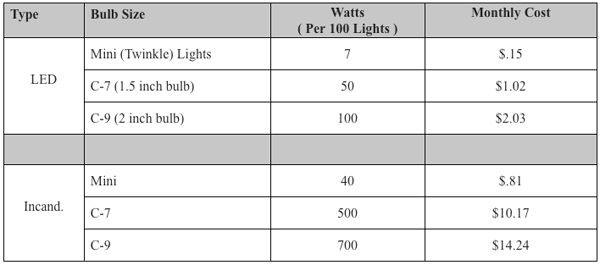Featured News - Current News - Archived News - News Categories
LEDs provide greater efficiency and safety
Editorial by National Grid
The holiday season will soon be ablaze with lights and festive displays of all shapes and sizes. As you contemplate just how many lights to put up this year, National Grid wants you to know you can do so without adding dramatically to your energy bill.
Light-emitting diode decorative light strings have definite advantages over the incandescent versions, because they use substantially less energy to produce the same amount of light. So, if you are thinking about chucking that tangled ball of light strings hiding in your basement and starting over, keep these cost comparisons in mind.

Based on a 100-light string with six hours usage per day for 30 days, at current National Grid rates.
While LEDs usually cost more to purchase, the potential for savings over time is significant. LEDs are generally more durable as the bulbs are made of epoxy rather than glass, and can last as much as 10 years longer than standard lights without fading. LEDs also are safer to use, as the bulbs remain cool to the touch no matter how long they have been on.
Here are some other efficiency and safety tips to keep the holidays healthy and affordable:
•Approved Lighting - Make sure your lights have a safety listing from a nationally recognized testing laboratory, such as the Underwriters Laboratories (UL). A safety approval seal means the lights have been tested and are safe to use. Use lights only as intended. Thoroughly examine all lights before putting them up, even newly purchased lights.
•Christmas Trees - If you have an artificial tree, make sure it's been tested for flammability by the Underwriters Laboratories. To prevent electrical shock, never use electric decorations on artificial trees with metallic needles, leaves or branches. Instead, place colored spotlights above or beside the tree—never attached to it. Keep your natural tree well-watered to prevent bulbs from igniting dry branches. Keep extension cords and light sets away from the tree stand.
•Don't Overload - Don't overload your electric circuits. Check your fuse or breaker panel to see how much your home can handle, and stay well within limits. String together only the number of lights recommended by the manufacturer.
•Avoid Shock - Make sure there's a bulb in each socket. If a bulb has burned out, leave it in until you have a replacement.
•Outdoor Connections - Plug outdoor lights into ground fault circuit interrupters, which are available at hardware and electrical supply stores. If there is an electrical fault with a light string, GFCIs will automatically shut off the electricity well before any electric shock could occur. Also, cover outdoor plugs and joints with a water-resistant layer of plastic wrap and electrical tape.
•Turn Off the Lights - Limit the time lights are on. Wait until dark to turn on your holiday lights; then, turn them off before you go to bed. Six hours or less of daily use is a good goal. Turning off room lights when the tree is lit also can make a difference. The lights on a holiday tree should provide more than enough lighting to navigate around the room.
For more information, visit our website: www.nationalgridus.com.





























